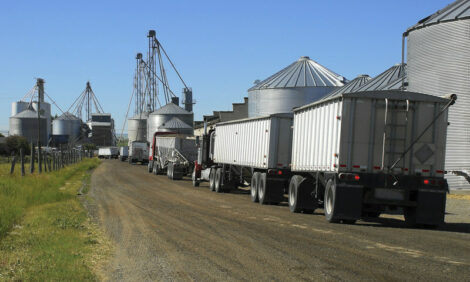



U of M Research Shows Pearling Barley Effective in Removing DON
CANADA - Farm-Scape: Episode 1412. Farm-Scape is a Wonderworks Canada production and is distributed courtesy of Manitoba Pork Council and Sask Pork.  Farm-Scape is sponsored by
Manitoba Pork Council and Sask Pork  Play Audio Play AudioFarm-Scape is a Wonderworks Canada production and is distributed courtesy of Manitoba Pork Council and Sask Pork. |
Farm-Scape, Episode 1412
Research at the University of Manitoba has shown it's possible to dramatically reduce the mycotoxin contamination of barley resulting from fusarium infection by pearling the grain.
Fusarium mycotoxin, primarily deoxynivalenon or DON, contamination of feed grain is know to reduce performance in the swine herd.
While studies suggests pigs are able to tolerate higher levels of DON than previously believed efforts to develop effective methods for cleaning contaminated grain continue.
Associate Professor Dr. Jim House says there are several methods for reducing mycotoxin levels in barley, including washing the grain, using chemical agents or pearling.
"Pearling is the one in particular that we've studied most recently to look at removing the outer portion of the grains that tend to be the most heavily contaminated with the mycotoxins and, at least for barley, it's a very effective approach.
We can get rid of the bulk of the mycotoxins simply by removing the outer hull of barley.
By simply removing the outer hull, which is about 15 percent of the weight of the barley kernel we can get rid of about 70 percent of the deoxynivalenon and we can realize even greater reductions if we go to higher levels of pearling.
We've just purchased a large pearling unit to try to scale this up so that we have enough material to do subsequent feeding studies to determine the best approach to get rid of the mycotoxins.
Once we know the process a little bit better we can turn it over to the engineers and say, 'this is what we need to have happen,' and they can start looking at optimizing the process".
Dr. House says the critical factor is that any strategy for cleaning the grain must be effective, it must be cost efficient and it can't negatively affect the nutrient profile of the grain.
He says pearling actually improves the grain's nutrient profile by increasing digestible energy as a result of removing the fiber in the hull fraction.
He says scientists plan to follow up with feeding studies to look at the true benefits of pearling.
For Farmscape.Ca, I'm Bruce Cochrane.








